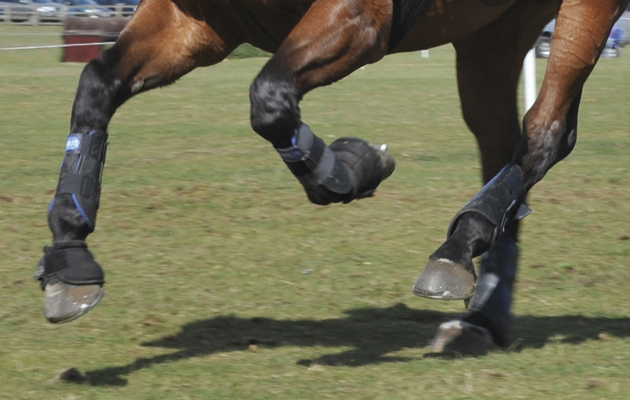How can we ensure competition horses enjoy their side of the partnership, asks Professor Madeleine Campbell MRCVS
Famous examples of horse-human partnerships have filled the pages of Horse & Hound this year. All of us involved in the equestrian world feel an intuitive “bond” between ourselves and our horses, which is very difficult to define but undoubtedly special. The reality is that however strongly we feel that bond, the partnership between a horse and a human is always, unavoidably, an unequal one.
Domesticated horses are dependent upon humans: both in a legal sense, because they are our property, and in an everyday sense in that they rely upon us for food, shelter, exercise and health care. We have it within our power to make horses’ lives miserable or enjoyable, and that power brings with it an enormous responsibility – a responsibility not only to treat horses as well as possible, but also to strive to understand better what horses need, in order to improve our treatment of them.
{"content":"PGgzPkJlaGF2aW91cmFsIGNsdWVzPC9oMz4KPHA+VGhlIHJlY2VudCBXb3JsZCBIb3JzZSBXZWxmYXJlIGNvbmZlcmVuY2Ugd2FzIGJhc2VkIGFyb3VuZCB0aGUgcXVlc3Rpb246IOKAnFRoZSBob3JzZS1odW1hbiBwYXJ0bmVyc2hpcCDigJMgd2hhdOKAmXMgaW4gaXQgZm9yIHRoZSBob3JzZXM\/4oCdIFNldCBhZ2FpbnN0IHRoZSBiYWNrZ3JvdW5kIG9mIGluY3JlYXNpbmcgc29jaWV0YWwgaW50ZXJlc3QgaW4gYW5pbWFsIGV0aGljcywgd2VsZmFyZSBhbmQgZXF1ZXN0cmlhbiBzcG9ydCwgdGhpcyBpcyBhIHBhcnRpY3VsYXJseSB0aW1lbHkgcXVlc3Rpb24gaW4gcmVsYXRpb24gdG8gY29tcGV0aXRpb24gaG9yc2VzLjwvcD4KPHA+U28sIHdoYXTigJlzIGluIGl0IGZvciB0aGUgY29tcGV0aXRpb24gaG9yc2U\/IFRoZSBzaW1wbGUgYW5zd2VyIGlzIHRoYXQgd2VsbCBsb29rZWQtYWZ0ZXIgZXF1aW5lIGF0aGxldGVzIGJlbmVmaXQgZnJvbSBvdXRzdGFuZGluZyB2ZXRlcmluYXJ5IGNhcmUsIGNhcmVmdWwgbWFuYWdlbWVudCBhbmQg4oCTIHZlcnkgb2Z0ZW4g4oCTIGEgaGFwcHkgcmV0aXJlbWVudC48L3A+CjxwPjxkaXYgY2xhc3M9ImFkLWNvbnRhaW5lciBhZC1jb250YWluZXItLW1vYmlsZSI+PGRpdiBpZD0icG9zdC1pbmxpbmUtMiIgY2xhc3M9ImlwYy1hZHZlcnQiPjwvZGl2PjwvZGl2PjxzZWN0aW9uIGlkPSJlbWJlZF9jb2RlLTMxIiBjbGFzcz0iaGlkZGVuLW1kIGhpZGRlbi1sZyBzLWNvbnRhaW5lciBzdGlja3ktYW5jaG9yIGhpZGUtd2lkZ2V0LXRpdGxlIHdpZGdldF9lbWJlZF9jb2RlIHByZW1pdW1faW5saW5lXzIiPjxzZWN0aW9uIGNsYXNzPSJzLWNvbnRhaW5lciBsaXN0aW5nLS1zaW5nbGUgbGlzdGluZy0tc2luZ2xlLXNoYXJldGhyb3VnaCBpbWFnZS1hc3BlY3QtbGFuZHNjYXBlIGRlZmF1bHQgc2hhcmV0aHJvdWdoLWFkIHNoYXJldGhyb3VnaC1hZC1oaWRkZW4iPg0KICA8ZGl2IGNsYXNzPSJzLWNvbnRhaW5lcl9faW5uZXIiPg0KICAgIDx1bD4NCiAgICAgIDxsaSBpZD0ibmF0aXZlLWNvbnRlbnQtbW9iaWxlIiBjbGFzcz0ibGlzdGluZy1pdGVtIj4NCiAgICAgIDwvbGk+DQogICAgPC91bD4NCiAgPC9kaXY+DQo8L3NlY3Rpb24+PC9zZWN0aW9uPjwvcD4KPHA+SWYgdGhlIG1ham9yaXR5IG9mIGNvbXBldGl0aW9uIGhvcnNlcyBjYW4gYW5kIGRvIGVuam95IHRob3NlIGJlbmVmaXRzLCB0aGVuLCBpbiB0aGVvcnksIGFsbCBvZiB0aGVtIGNvdWxkLiBFdmVyeSByZXNwb25zaWJsZSBwZXJzb24gd29ya2luZyB3aXRoaW4gdGhlIGVxdWluZSBpbmR1c3RyeSBob2xkcyB0aGF0IGFtYml0aW9uLCBhbmQgdGhvc2Ugd2hvIGRvIG5vdCBkZWxpdmVyIHVwb24gaXQgc2hvdWxkIGJlIGRlYWx0IHdpdGggYXBwcm9wcmlhdGVseSBieSByZWd1bGF0b3JzIGFuZCB0aGUgbGF3LjwvcD4KPHA+QnV0IHdlIG5lZWQgdG8gZXh0ZW5kIHRoZSB3YXkgaW4gd2hpY2ggd2UgdGhpbmsgYWJvdXQgd2VsZmFyZSwgYmV5b25kIHNvbGVseSBjb25zaWRlcmluZyBob3cgd2UgbWVldCB2ZXRlcmluYXJ5IGFuZCBldmVyeWRheSBuZWVkcy4gV2Ugc2hvdWxkIGJlIGFza2luZyBvdXJzZWx2ZXM6IOKAnEhvdyB3ZSBjYW4gbW9yZSBob2xpc3RpY2FsbHkgaW1wcm92ZSB0aGUgd2VsZmFyZSBvZiBob3JzZXMgaW4gdHJhaW5pbmcgYW5kIGluIGNvbXBldGl0aW9uLCBib3RoIHRocm91Z2ggbWluaW1pc2luZyBuZWdhdGl2ZSB3ZWxmYXJlIGltcGFjdHMgYW5kIG1heGltaXNpbmcgcG9zaXRpdmUgaW1wYWN0cz\/igJ08L3A+CjxwPldlIG5lZWQgdG8gYmUgYWJsZSB0byB1bmRlcnN0YW5kLCBmb3IgZXhhbXBsZSwgd2hpY2ggb2YgdHdvIHBvc3NpYmxlIHRyYWluaW5nIG1ldGhvZHMgaXMgYmV0dGVyIGZvciB0aGUgd2VsZmFyZSBvZiB0aGUgaG9yc2UsIGFuZCB3aGF0IHRoZSBjb21wYXJhdGl2ZSBlZmZlY3RzIG9mIGFsdGVybmF0aXZlIGl0ZW1zIG9mIHRhY2sgYW5kIGVxdWlwbWVudCBhcmUuIFRvIGRvIHRoYXQsIHdlIG5lZWQgc29tZSB1bmRlcnN0YW5kaW5nIG9mIGhvdyB0aGUgaG9yc2UgZmVlbHMuPC9wPgo8ZGl2IGNsYXNzPSJhZC1jb250YWluZXIgYWQtY29udGFpbmVyLS1tb2JpbGUiPjxkaXYgaWQ9InBvc3QtaW5saW5lLTMiIGNsYXNzPSJpcGMtYWR2ZXJ0Ij48L2Rpdj48L2Rpdj4KPHA+Rm9ydHVuYXRlbHksIG92ZXIgdGhlIHBhc3QgZGVjYWRlLCB0aGlzIGhhcyBiZWNvbWUgYSBsb3QgZWFzaWVyIHRoYW5rcyB0byB0aGUgZGV2ZWxvcG1lbnRzIGluIHRoZSBmaWVsZCBvZiBlcXVpbmUgZXRob2xvZ3kgYW5kIG9mIHZhcmlvdXMgZXF1aW5lIHdlbGZhcmUgYXNzZXNzbWVudCB0b29scy48L3A+CjxwPkV0aG9sb2d5IGlzIHRoZSBzdHVkeSBvZiBhbmltYWwgYmVoYXZpb3VyLiBBIG1ham9yIGRldmVsb3BtZW50IGluIHRoZSBwYXN0IGRlY2FkZSBoYXMgYmVlbiB0aGUgc3lzdGVtYXRpYyBpbnZlc3RpZ2F0aW9uIG9mIGVxdWluZSBmYWNpYWwgZXhwcmVzc2lvbnMgYXMgYSByZWZsZWN0aW9uIG9mIGEgaG9yc2XigJlzIGVtb3Rpb25hbCBzdGF0ZS48L3A+CjxkaXYgY2xhc3M9ImFkLWNvbnRhaW5lciBhZC1jb250YWluZXItLW1vYmlsZSI+PGRpdiBpZD0icG9zdC1pbmxpbmUtNCIgY2xhc3M9ImlwYy1hZHZlcnQiPjwvZGl2PjwvZGl2Pgo8cD5TZXZlcmFsIHN0dWRpZXMgaGF2ZSBlbHVjaWRhdGVkIHRoZSBmYWNpYWwgZXhwcmVzc2lvbnMgb2YgaG9yc2VzIHRoYXQgYXJlIGFzc29jaWF0ZWQgd2l0aCBwYWluIOKAkyBpbmNsdWRpbmcgc3RpZmZseSBiYWNrd2FyZHMgZWFycyBhbmQgc3RyYWluZWQgbm9zdHJpbHMg4oCTIGFuZCBoYXZlIGRldmVsb3BlZCBhbiBvYmplY3RpdmUgaG9yc2UgZ3JpbWFjZSBzY2FsZS48L3A+CjxwPk1vcmUgcmVjZW50bHksIGFuZCB2ZXJ5IHJlbGV2YW50IHRvIHRoZSBmYWN0IHRoYXQgd2UgYXJlIHRyeWluZyB0byBtYXhpbWlzZSBwb3NpdGl2ZSB3ZWxmYXJlIHN0YXRlcyBhcyB3ZWxsIGFzIG1pbmltaXNlIG5lZ2F0aXZlIG9uZXMsIG9iamVjdGl2ZSBzdHVkaWVzIGhhdmUgZGVtb25zdHJhdGVkIGVxdWluZSBmYWNpYWwgZXhwcmVzc2lvbnMgYXNzb2NpYXRlZCB3aXRoIHBvc2l0aXZlIGVtb3Rpb25zLjxiciAvPgpBcyBhbiBleGFtcGxlLCBleWUgd3JpbmtsZSBleHByZXNzaW9uIGNhbiBpbmRpY2F0ZSBib3RoIG5lZ2F0aXZlIGFuZCBwb3NpdGl2ZSwgd2l0aCB0aGUgYW5nbGUgYmV0d2VlbiB0aGUgbGluZSB0aHJvdWdoIHRoZSBleWViYWxsIGFuZCB0aGUgaGlnaGVzdCBza2luIHdyaW5rbGUgYWJvdmUgdGhlIGV5ZSBkZWNyZWFzaW5nIGR1cmluZyBwb3NpdGl2ZSBzdGF0ZXMuPC9wPgo8ZGl2IGNsYXNzPSJhZC1jb250YWluZXIgYWQtY29udGFpbmVyLS1tb2JpbGUiPjxkaXYgaWQ9InBvc3QtaW5saW5lLTUiIGNsYXNzPSJpcGMtYWR2ZXJ0Ij48L2Rpdj48L2Rpdj4KPGgzPlByb29mIHBvc2l0aXZlPC9oMz4KPHA+SXQgaXMgdW5saWtlbHkgdGhhdCB0aGlzIG5ld3Mgd2lsbCBjb21lIGFzIGEgc3VycHJpc2UgdG8gdGhvc2Ugb2YgdXMgd2hvIHNwZW5kIG91ciBsaXZlcyBhcm91bmQgaG9yc2VzLiBUaGUgdmFsdWUgb2YgaGF2aW5nIHRoZSBldmlkZW5jZSBiYXNlIHByb3ZlZCBpbiB0aGlzIHdheSwgaG93ZXZlciwgaXMgdHdvZm9sZCwgZW5hYmxpbmcgdXMgdG8gcHJvbW90ZSBnb29kIGVxdWluZSB3ZWxmYXJlIHRocm91Z2ggaW5jcmVhc2luZyBvdXIgb3duIGF3YXJlbmVzcyBhbmQgZWR1Y2F0aW5nIHRob3NlIGZvciB3aG9tIHN1Y2ggYmVoYXZpb3VyYWwgaW5kaWNhdG9ycyBhcmUgbm90IHBlcmhhcHMgc28gb2J2aW91cy4gSXQgYWxzbyBwcm92aWRlcyB1cyB3aXRoIG9iamVjdGl2ZSBjcml0ZXJpYSB3aXRoIHdoaWNoIHRvIHRlc3QgdGhlIGVmZmVjdCBvZiBhY3Rpb25zIG9uIG91ciBlcXVpbmUgcGFydG5lcnMuPC9wPgo8cD5SZXNlYXJjaCBoYXMgc2hvd24gdGhhdCBpdCBpcyBub3Qgb25seSBmYWNpYWwgZXhwcmVzc2lvbnMgdGhhdCBhcmUgcmVsZXZhbnQgdG8gdW5kZXJzdGFuZGluZyBhbmQgc2FmZWd1YXJkaW5nIHRoZSB3ZWxmYXJlIG9mIGhvcnNlcyBiZWluZyB1c2VkIGZvciBjb21wZXRpdGlvbiwgYnV0IGEgd2hvbGUgcmFuZ2Ugb2Ygb3RoZXIgYmVoYXZpb3Vycy48L3A+CjxwPldlIG5vdyBoYXZlIGFjY2VzcyB0byBhIHJpZGRlbiBob3JzZSBldGhvZ3JhbSB3aGljaCByZWxhdGVzIDI0IHJpZGRlbiBiZWhhdmlvdXJzIHRvIHBhaW4uIE9uY2Ugd2UgdW5kZXJzdGFuZCBhbmQgY2FuIGludGVycHJldCBmYWNpYWwgZXhwcmVzc2lvbnMgYW5kIGdlbmVyYWwgYmVoYXZpb3Vycywgd2UgY2FuIHVzZSB0aGF0IGtub3dsZWRnZSB0byB1bmRlcnN0YW5kIGhvdyBlcXVpcG1lbnQgYW5kIHRyYWluaW5nIHRlY2huaXF1ZXMgbWF5IGhhdmUgYSBuZWdhdGl2ZSBvciBwb3NpdGl2ZSB3ZWxmYXJlIGltcGFjdC48L3A+CjxwPlRoZSBwb3RlbnRpYWwgb2YgZXF1aW5lIGV0aG9sb2d5IHRvIGltcHJvdmUgdGhlIHdlbGZhcmUgb2YgY29tcGV0aXRpb24gaG9yc2VzIGlzIGNvbXBsZW1lbnRlZCBieSByZWNlbnQgZGV2ZWxvcG1lbnRzIG9mIGVxdWluZSB3ZWxmYXJlIGFzc2Vzc21lbnQgdG9vbHMuIFRoZXNlIHByb3ZpZGUgYW4gb2JqZWN0aXZlIG1lYW5zIG9mIGFzc2Vzc2luZyB0aGUgd2VsZmFyZSBpbXBhY3RzIG9mIG1hbmFnZW1lbnQgbWV0aG9kcy48L3A+CjxwPk9uZSBzdWNoIHdvcmsgaGFzIGVzdGFibGlzaGVkIGhvdyB3ZSBjYW4gdXNlIGEgd2VsZmFyZSBtb2RlbCBrbm93biBhcyB0aGUgZml2ZSBkb21haW5zIHRvIGFzc2VzcyB0aGUgaW1wYWN0IG9mIHRyYW5zcG9ydGF0aW9uLiBUaGlzIHdpbGwgaGVscCB1cyBhbnN3ZXIgYXQgYW4gaW5kaXZpZHVhbCBob3JzZSBsZXZlbCBxdWVzdGlvbnMgc3VjaCBhcyB3aGV0aGVyIGl0IGlzIGJldHRlciB0byB0cmF2ZWwgYSBob3JzZSBob21lIGltbWVkaWF0ZWx5IGFmdGVyIGEgY29tcGV0aXRpb24gc28gaGUgY2FuIHJlc3QgaW4gaGlzIG93biBzdGFibGUgdGhhdCBuaWdodCwgb3IgdG8gc3RheSBvdmVybmlnaHQgYXQgdGhlIHZlbnVlIGFuZCB0cmF2ZWwgdGhlIG5leHQgZGF5LjwvcD4KPHA+QW5vdGhlciBpbnRlcmVzdGluZyBhcmVhIG9mIHdvcmsgaXMgdGhlIGRldmVsb3BtZW50IG9mIGFuIGFuaW1hbCB3ZWxmYXJlIGFzc2Vzc21lbnQgZ3JpZCAoQVdBRyksIGEgY2xvdWQtYmFzZWQgdGVjaG5vbG9naWNhbCB0b29sIHdoaWNoIGNhbiBiZSB1c2VkIGJ5IGFueW9uZSBpbiB0aGUgZmllbGQuIFByZXZpb3VzbHksIHRoaXMgaGFzIGJlZW4gdXNlZCB0byBhc3Nlc3MgdGhlIHdlbGZhcmUgb2Ygem9vIGFuaW1hbHMga2VwdCBpbiBhbiB1bm5hdHVyYWwgZW52aXJvbm1lbnQuPC9wPgo8cD5Xb3JrIHRvIGFkYXB0IHRoZSBBV0FHIHNwZWNpZmljYWxseSBmb3IgdXNlIGluIGhvcnNlcyBpcyBvbmdvaW5nIGFuZCBpcyB0aGUgc3ViamVjdCBvZiBjdXJyZW50IGdyYW50IGFwcGxpY2F0aW9ucy48L3A+CjxoMz5GaW5kaW5nIGEgYmFsYW5jZTwvaDM+CjxwPk9vdXIgcGFydG5lcnNoaXAgd2l0aCBjb21wZXRpdGlvbiBob3JzZXMgaXMgdW5hdm9pZGFibHkgdW5lcXVhbC4gTm9uZXRoZWxlc3MsIHRoaXMgcmVsYXRpb25zaGlwIGNhbiBiZSBtdXR1YWxseSBhZHZhbnRhZ2VvdXMgYW5kIGVuam95YWJsZSBpZiB3ZSBzdHJpdmUgY29uc3RhbnRseSB0byBwcm92aWRlIHdlbGZhcmUtZW5oYW5jaW5nIGV4cGVyaWVuY2VzIGFuZCBtaW5pbWlzZSBuZWdhdGl2ZSBvbmVzLjwvcD4KPHA+QnkgYXBwbHlpbmcgdGhlIHJlc2VhcmNoIGludG8gZXF1aW5lIGV0aG9sb2d5LCBlcXVpbmUgd2VsZmFyZSBhc3Nlc3NtZW50IHRvb2xzIGFuZCBlcXVpbmUgY29nbml0aW9uLCB0aG9zZSByZXNwb25zaWJsZSBmb3IgY29tcGV0aXRpb24gaG9yc2VzIGNhbiBkbyB0aGlzLCBieSBtYWtpbmcgb2JqZWN0aXZlLCBldmlkZW5jZS1iYXNlZCBkZWNpc2lvbnMgYWJvdXQgZXF1aXBtZW50LCBtZXRob2RzIGFuZCBtYW5hZ2VtZW50LjwvcD4KPHA+R29pbmcgaW50byAyMDIxIGFuZCBiZXlvbmQsIGFzIG1lbWJlcnMgb2YgdGhlIGVxdWluZSBpbmR1c3RyeSB3ZSBtdXN0IHN0cml2ZSBub3Qgb25seSB0byBhcHBseSBvdXIgY3VycmVudCBrbm93bGVkZ2UgdG8gZW5oYW5jZSB3ZWxmYXJlLCBidXQgYWxzbyB0byB3b3JrIHRvZ2V0aGVyIHRvIGFzc2VzcyBhc3BlY3RzIG9mIGhvcnNlc+KAmSBsaXZlcyB3aGljaCB3ZSBtYXkgbm90IHByZXZpb3VzbHkgaGF2ZSBjb25zaWRlcmVkLjwvcD4KPGgzPkZhY2luZyBmYWN0czwvaDM+CjxwPkFuIGFyZWEgb2YgcmVzZWFyY2ggd2hpY2ggaXMgb2YgZGlyZWN0IHJlbGV2YW5jZSB0byB0aGUgd2VsZmFyZSBvZiBjb21wZXRpdGlvbiBob3JzZXMgcmVsYXRlcyB0byBvdXIgdW5kZXJzdGFuZGluZyBvZiBlcXVpbmUgY29nbml0aW9uLCB3aGljaCBpcyB0aGUgYWJpbGl0eSB0byBsZWFybiBmcm9tIGV4cGVyaWVuY2Ug4oCTIHNwZWNpZmljYWxseSwgdGhlIGVmZmVjdCBvdXIgb3duIGVtb3Rpb25hbCBzdGF0ZSBjYW4gaGF2ZSB1cG9uIHRoYXQgb2Ygb3VyIGhvcnNlcy48L3A+CjxwPkV2aWRlbmNlIHN1Z2dlc3RzIHRoYXQgaG9yc2VzIGNhbiByZWFkIGFuZCByZW1lbWJlciBodW1hbiBlbW90aW9ucy4gUmVzZWFyY2ggaGFzIHNob3duIHRoYXQgbm90IG9ubHkgY2FuIGEgaG9yc2UgaWRlbnRpZnkgYmV0d2VlbiBhbiBhbmdyeSBodW1hbiBmYWNlIGFuZCBhIGhhcHB5IG9uZSwgYnV0IGFsc28gdGhhdCBoZSBtYXkgcmVjYWxsIHRoZSBwcmV2aW91cyBmYWNpYWwgZXhwcmVzc2lvbiBvZiBhIHBlcnNvbiB3aGVuIGhlIG1lZXRzIHRoZW0gYWdhaW4g4oCTIGFuZCBhZGFwdCBoaXMgYmVoYXZpb3VyIGFjY29yZGluZ2x5LjwvcD4KPGRpdiBjbGFzcz0iaW5qZWN0aW9uIj48L2Rpdj4KPHA+SG9yc2VzIHRlbmQgdG8gdmlldyBuZWdhdGl2ZSBldmVudHMgd2l0aCB0aGVpciBsZWZ0IGV5ZSwgcHJvY2Vzc2luZyB0aGlzIHBvdGVudGlhbGx5IHRocmVhdGVuaW5nIHN0aW11bGkgaW4gdGhlIHJpZ2h0IGhlbWlzcGhlcmUgb2YgdGhlIGJyYWluLiBJbiBzdHVkaWVzIGxlZCBieSBQcm9mZXNzb3IgS2FyZW4gTWNDb21iIGFuZCBEciBMZWFubmUgUHJvb3BzLCBob3JzZXMgc3BlbnQgbW9yZSB0aW1lIHN0dWR5aW5nIGEgcGVyc29u4oCZcyBmYWNlIHdpdGggdGhlaXIgbGVmdCBleWUgaWYgdGhleSBoYWQgcHJldmlvdXNseSBzZWVuIGEgcGhvdG8gb2YgdGhlbSBsb29raW5nIGFuZ3J5IChwaWN0dXJlZCkuIElkZWFsbHksIHN1Y2ggZmluZGluZ3Mgd2lsbCBtYWtlIHVzIGFsbCB0aGluayBtb3JlIGNhcmVmdWxseSBhYm91dCB3aGF0IHdlIHByb2plY3Qgd2hlbiB3ZSBpbnRlcmFjdCB3aXRoIGhvcnNlcyBpbiBvdXIgY2FyZS48L3A+CjxoMz5GdXJ0aGVyIHJlYWRpbmc8L2gzPgo8cD5UbyBmaW5kIG91dCBtb3JlLCBzZWFyY2ggZm9yIHRoZXNlIHJlc2VhcmNoZXJzIGFuZCBvdGhlcnM6PC9wPgo8cD5Ib3JzZSBncmltYWNlIHNjYWxlOiBFIERhbGxhIENvc3RhOyBLIEJlY2ggR2xlZXJ1cDxiciAvPgpFeWUgd3JpbmtsZSBleHByZXNzaW9uOiBTIEhpbnR6ZTxiciAvPgpBV0FHOiBTIFdvbGZlbnNvaG48YnIgLz4KRXF1aW5lIGJlaGF2aW91cjogQyBIYWxsOyBDIEhlbGVza2k8YnIgLz4KUmlkZGVuIGhvcnNlIGV0aG9ncmFtOiBTIER5c29uPGJyIC8+CkZpdmUgZG9tYWluczogUCBNY0dyZWV2eTwvcD4KPHA+PGVtPlJlZjogSG9yc2UgJmFtcDsgSG91bmQ7IDMxIERlY2VtYmVyIDIwMjA8L2VtPjwvcD4KPHA+Cg=="}
You may also be interested in:


